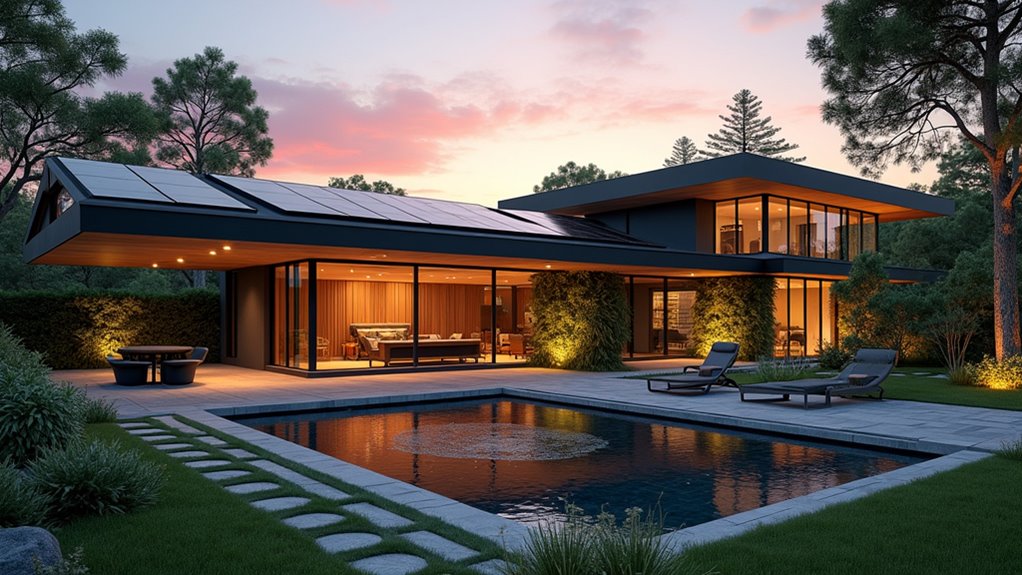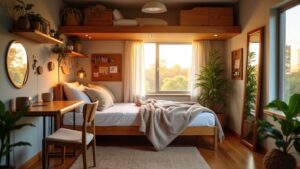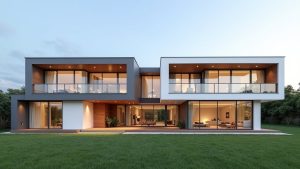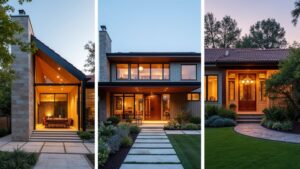In 2025, innovative house designs fuse timeless elegance with sustainability. Classic design elements feature neutral palettes and natural materials like reclaimed wood. Biophilic concepts create seamless indoor-outdoor connections, enhancing tranquility. Smart home technologies optimize energy efficiency through advanced insulation and IoT integration. Modular and prefabricated solutions allow customization while minimizing construction time. Additionally, multi-functional spaces utilize adaptable layouts and versatile furniture. Together, these elements redefine modern living, setting a new standard in architecture as further insights await exploration.
Key Takeaways
- Incorporate modular design principles to allow customizable living spaces that can adapt to changing family needs over time.
- Utilize sustainable materials like bamboo and reclaimed wood to reduce environmental impact while enhancing aesthetic appeal.
- Integrate smart home technologies for automated systems that optimize energy efficiency and improve the overall living experience.
- Design multi-functional spaces with modular furniture to accommodate various activities and promote flexible use of home areas.
- Establish strong indoor-outdoor connections through large windows and outdoor living areas, enhancing natural light and promoting tranquility.
Timeless Elegance With Classic Design Elements
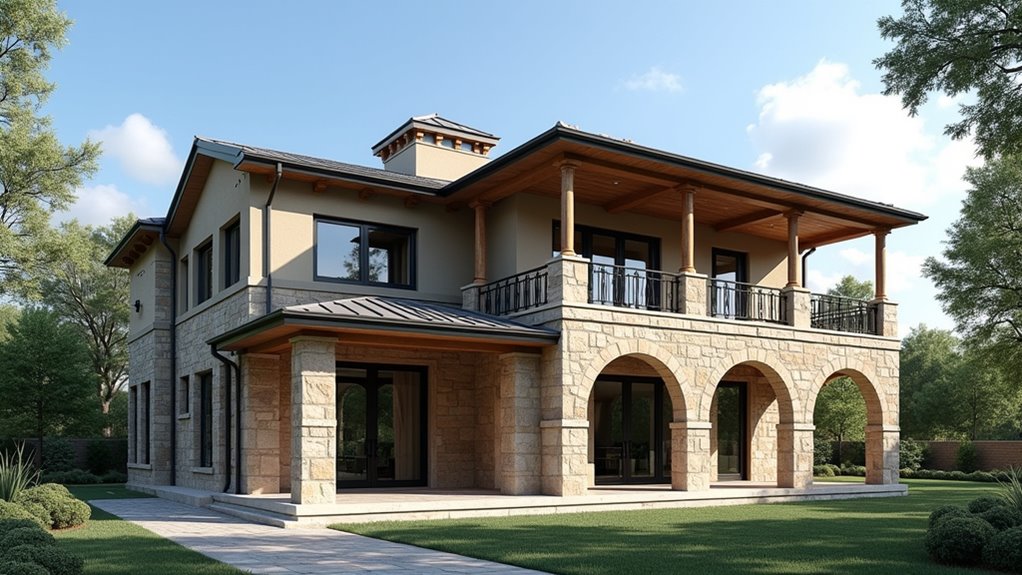
While trends may come and go, the essence of timeless elegance is embodied in classic design elements that transcend fleeting fashions. Neutral color palettes, featuring warm beiges and gentle grays, serve as calming backdrops that harmoniously blend with both classic finishes and modern accents. Thoughtfully integrated natural materials, such as reclaimed wood and stone, enhance authenticity while showcasing visual interest. Incorporating natural elements into these designs further promotes a connection to nature, enhancing the overall well-being of the inhabitants. Additionally, the use of repurposed and vintage materials in construction emphasizes sustainability and reflects a commitment to enduring craftsmanship. The inclusion of eco-friendly materials is crucial in ensuring that modern designs are both durable and environmentally conscious.
Functional layouts prioritize open spaces yet maintain distinctly zoned areas, promoting both flow and intimacy. Architectural details like crown molding and paneled doors enrich interiors with timeless details and craftsmanship. Moreover, strategic lighting designs that layer ambient, task, and accent options elevate these spaces, creating an inviting atmosphere that effortlessly balances tradition with contemporary living for years to come.
Embracing Warm Minimalism and Farmhouse Aesthetics
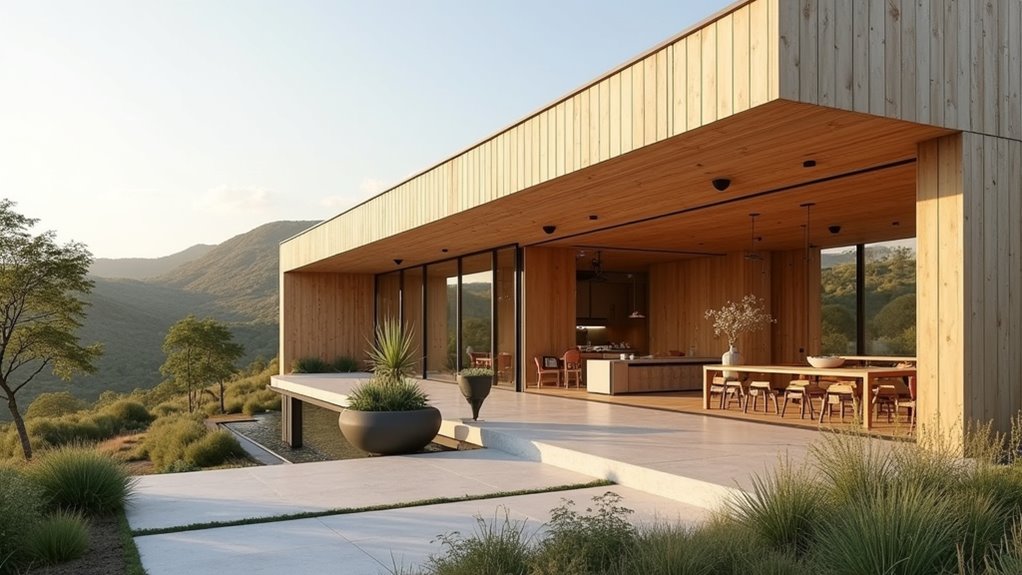
In 2025, a synergy of warm minimalism and farmhouse aesthetics captivates homeowners seeking a refined yet inviting environment. This design approach embraces warm materials and minimal decor, harmonizing sleek lines with organic textures. A neutral palette infused with earthy tones fosters a calming atmosphere, while modern geometric patterns refresh traditional motifs. Key elements include polished wood surfaces and brushed brass accents, lending sophistication to rustic charm. Layered lighting techniques create warmth, enhancing multi-functional spaces that prioritize sustainability. The integration of outdoor living spaces further encourages a seamless connection between nature and home.
| Design Element | Features | Purpose |
|---|---|---|
| Warm Materials | Natural fibers, wood, stone | Enhance warmth and texture |
| Minimal Decor | Simple, elegant accents | Create uncluttered spaces |
| Multi-Functional Spaces | Versatile room layouts | Optimize functionality |
| Earthy Color Palette | Soft, warm tones | Establish a calming ambiance |
Biophilic Design for Indoor-Outdoor Living
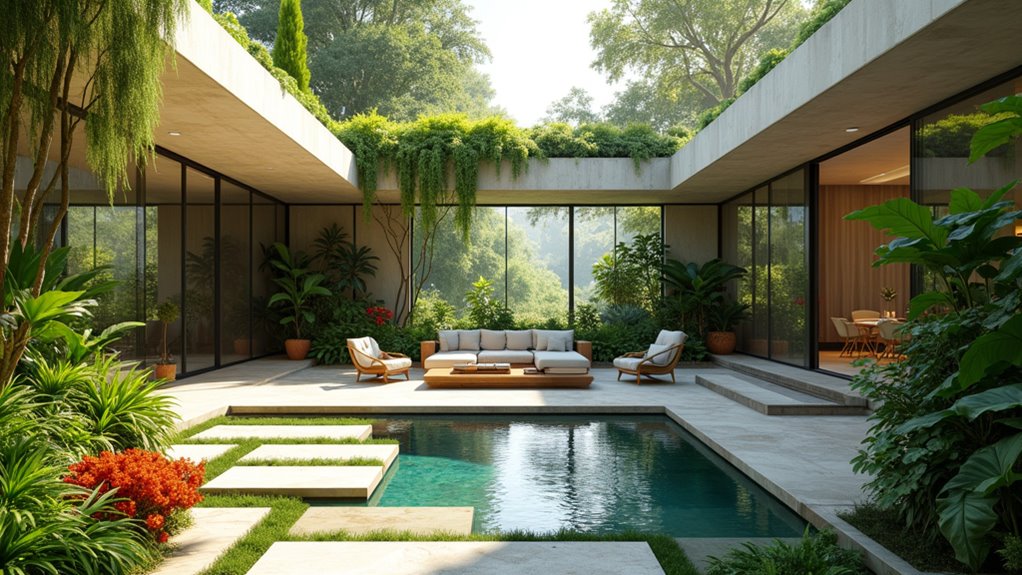
The integration of biophilic design principles serves to enhance the seamless relationship between indoor and outdoor living, building on the foundation established by warm minimalism and farmhouse aesthetics.
Key elements such as large windows and skylights maximize natural light, while living walls and vertical gardens incorporate nature within the home.
Outdoor living areas, like courtyards, actively blur boundaries, promoting biophilic benefits by fostering a sense of tranquility and connection to the environment.
Utilizing natural materials, biomorphic shapes, and soothing color schemes inspired by nature creates a cohesive aesthetic.
Furthermore, smart green technologies optimize energy efficiency, while natural ventilation systems ensure fresh airflow, culminating in a harmonious synthesis of nature integration that significantly elevates well-being in contemporary spaces. Additionally, features like smart thermostats and automated LED lighting can significantly reduce energy waste for a more sustainable home environment.
Sustainable Building Practices for Eco-Friendly Homes
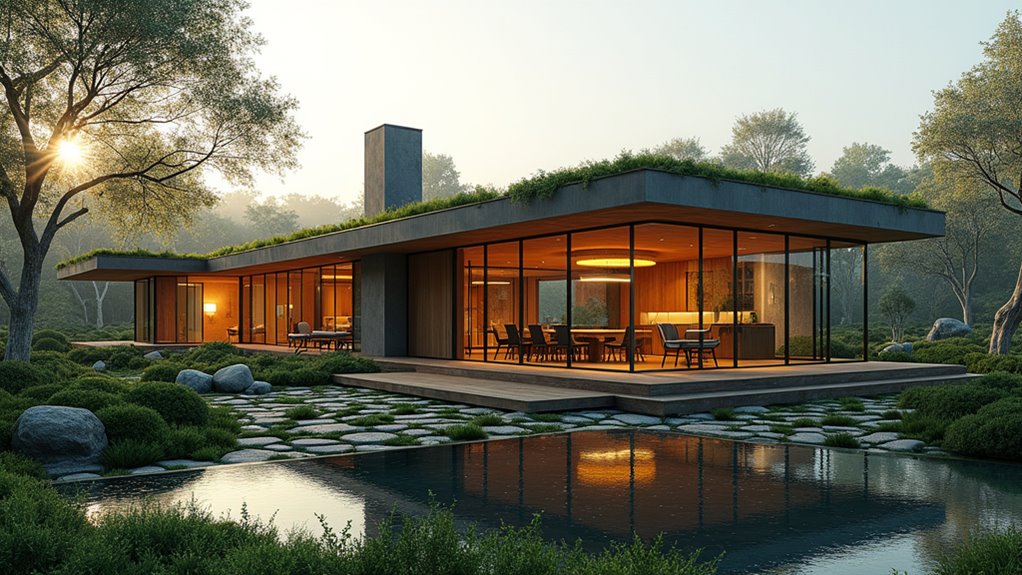
As the demand for eco-friendly homes continues to rise, sustainable building practices are emerging as crucial components in modern construction. Utilizing sustainable materials like bamboo flooring and reclaimed wood not only enhances aesthetic appeal but also reduces reliance on newly harvested resources. Energy-efficient systems, such as high-performance insulation and energy-efficient windows, play a pivotal role in minimizing energy consumption, while strategic orientation maximizes natural lighting. Furthermore, prefabricated construction techniques significantly cut down material waste and environmental disruption. Incorporating eco-friendly designs ensures that homes are resistant to tropical climates and blend cultural heritage with modern living. Achieving green certifications, including LEED and Cradle to Cradle, ensures that these homes meet rigorous sustainability standards. By embracing these practices, builders contribute to a healthier planet and create homes that harmoniously blend innovation with environmental responsibility.
Smart Home Technologies for Enhanced Efficiency

Smart home technologies are revolutionizing the way households operate, delivering unparalleled efficiency and convenience through sophisticated systems and interconnected devices.
The rise of smart home automation, fueled by IoT, allows homeowners to control various appliances and systems seamlessly. Advanced AI-driven systems optimize energy management by analyzing consumption patterns and integrating renewable resources, ensuring sustainability.
With voice-controlled automation, tasks such as lighting adjustments and climate control become intuitive, transforming user interactions into personalized experiences. Predictive analytics provide insights for maintenance, reducing costs and enhancing the home’s longevity.
Moreover, enhanced security measures through AI monitor real-time threats, creating a safe living environment. Collectively, these innovations signify a transformative era in home design, where efficiency and comfort harmoniously coexist.
Personalized Spaces for Functional Living
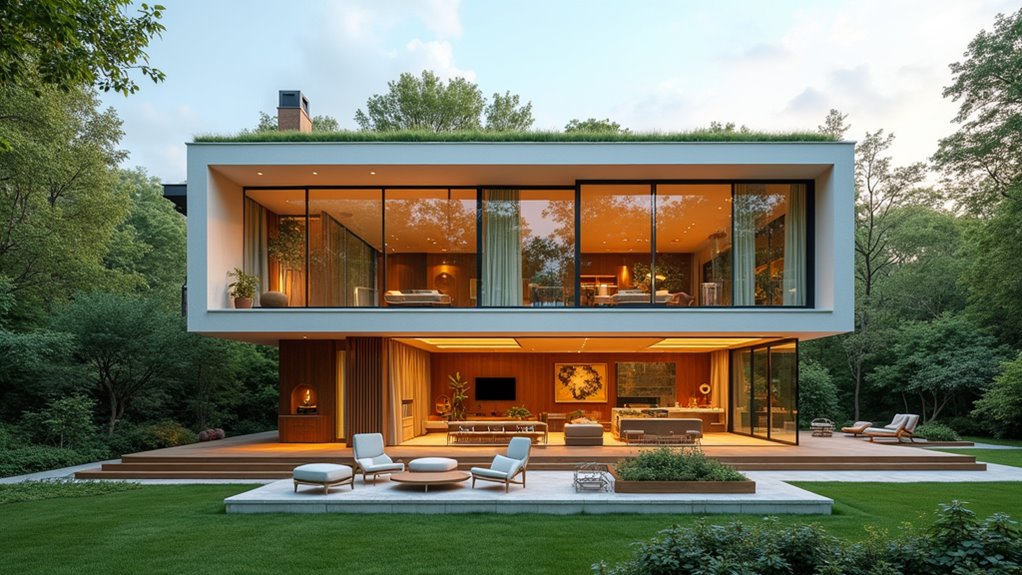
How can personalized spaces enhance the functionality of modern living? By integrating personalized layouts that prioritize individual needs, modern homes achieve both beauty and purpose.
Functional aesthetics play a pivotal role, where thoughtful designs foster wellness through natural light and air quality systems. Custom cabinetry and adaptable furniture transform static areas into dynamic spaces, accommodating various activities seamlessly.
Open-concept designs encourage fluid movement while retaining privacy through creative room dividers. Additionally, incorporating nature-inspired elements, such as plants and eco-friendly materials, elevates the atmosphere, further personalizing the experience.
These innovative approaches promote mental and physical well-being, revealing how personalized spaces are essential for crafting functional living environments that resonate with contemporary lifestyles.
Innovative Materials for Modern Construction
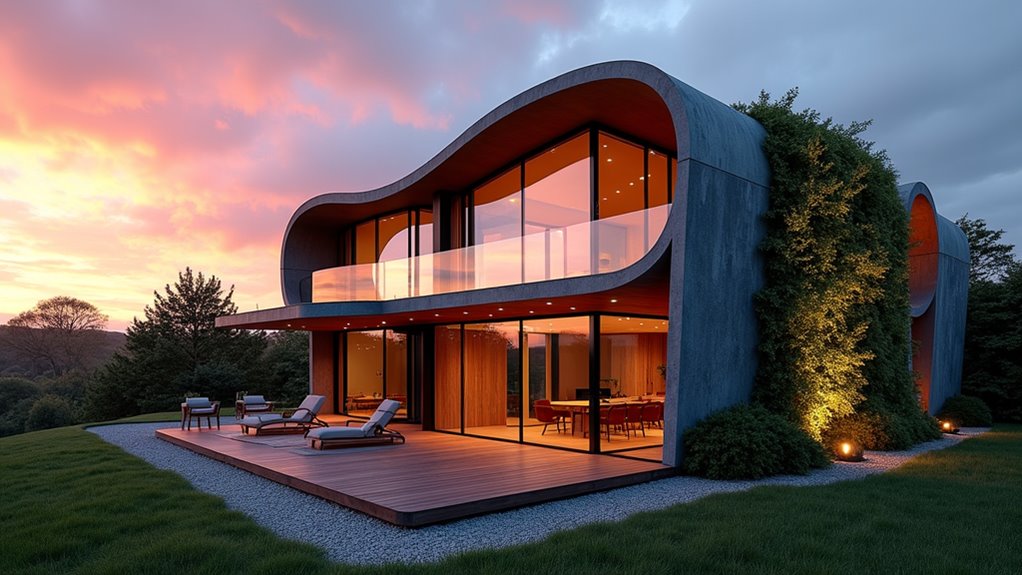
Personalized living spaces set the stage for a demand in innovative materials that not only support individual needs but also prioritize sustainability and efficiency in modern construction.
The industry has seen a rise in bio-based composites, leveraging natural fibers combined with resins to create lightweight and strong materials. Mycelium products are gaining traction for their ability to provide durable, decomposable structures. Additionally, the emergence of smart insulation technologies enables enhanced thermal performance in residences.
- Carbon fiber enhances the structural integrity of traditional materials while reducing weight.
- Mycelium insulation panels offer biodegradable solutions that support environmental goals.
- Smart insulation systems regulate energy usage, effectively shrinking carbon footprints.
This convergence of innovative materials signals a transformative era in construction.
Modular and Prefabricated Design Solutions
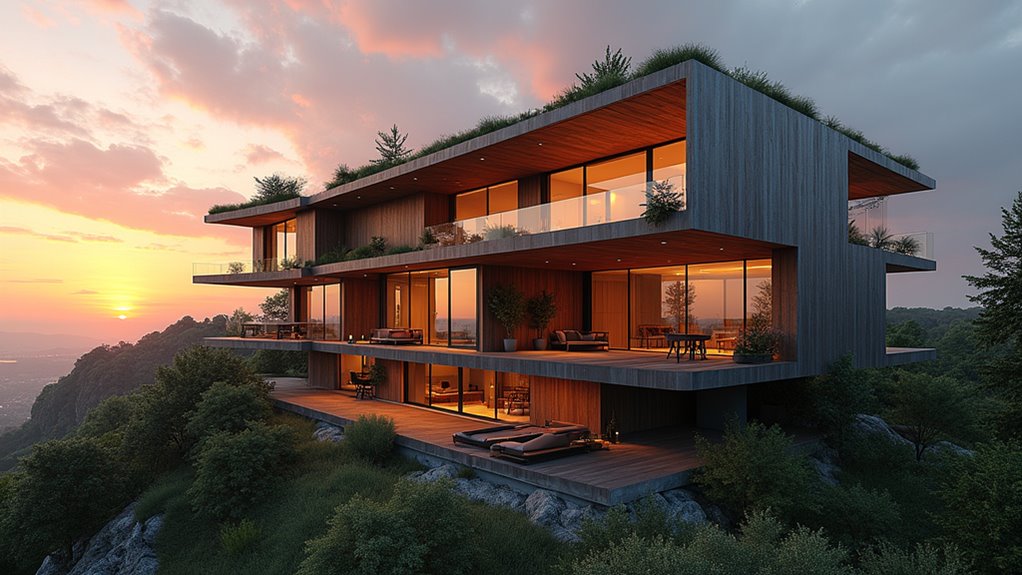
Modular and prefabricated design solutions represent a revolutionary shift in the construction landscape, crafting homes that seamlessly merge functionality with innovative design.
These solutions capitalize on modular adaptability, enabling homeowners to customize spaces effortlessly, ensuring a match to personal lifestyles. Prefabricated efficiency reduces construction timelines significantly, leading to cost-effective housing without compromising quality.
With advancements in hybrid construction techniques, these homes are increasingly built with eco-friendly materials, promoting sustainability. Influenced by trends such as multi-functional spaces and smart technologies, modular homes are redefining modern living.
As urban landscapes evolve, the integration of renewable energy sources further enhances their appeal, making them a compelling choice for future housing developments.
Advanced Window Technologies for Comfort
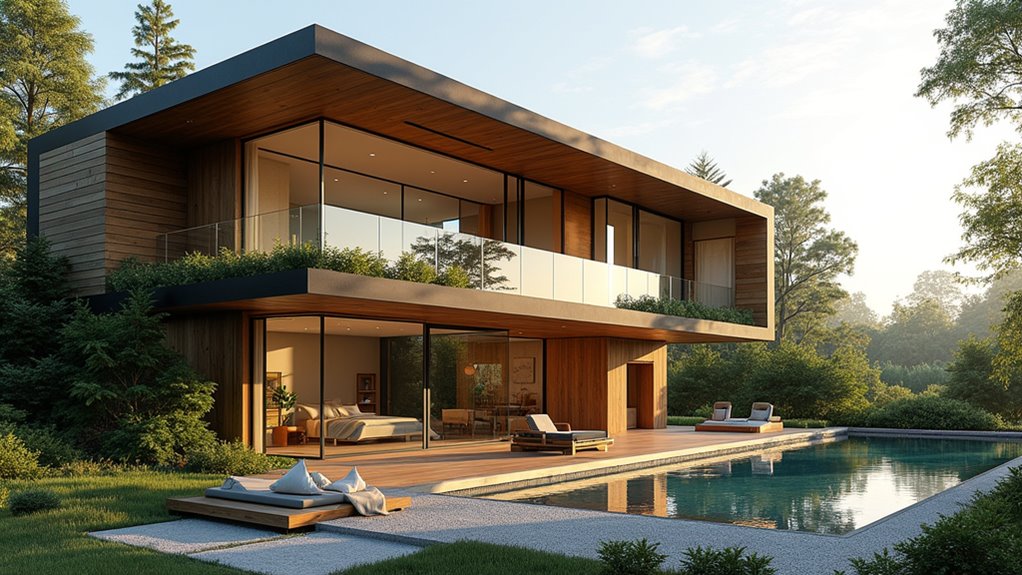
Advanced window technologies are redefining home comfort by ingeniously combining efficiency and innovation. The rise of energy-efficient windows enhances thermal performance, while smart glass innovations offer adaptive solutions to changing environmental conditions.
Homeowners now enjoy significant benefits including:
- Reduced Energy Bills: Advanced insulating technologies cut heat loss by up to 50%.
- Enhanced Comfort: Low-E coatings maintain consistent indoor temperatures and prevent drafts.
- Noise Reduction: Energy-efficient windows also dampen external sounds, creating a serene indoor environment.
Furthermore, materials like fiberglass and advanced glazing ensure durability, requiring minimal maintenance.
The integration of features such as smart window controls empowers homeowners to optimize energy use effortlessly, leading towards sustainable living without compromising style or comfort.
Creating Multi-Functional and Adaptive Rooms

The evolution of home design continues alongside innovations in window technology, leading to a heightened focus on creating multi-functional and adaptive rooms.
These spaces combine living, working, and leisure activities, maximizing every square foot for efficiency. Flexible layouts allow for seamless transitions, where a living room can quickly transform into an office or a guest bedroom can double as a gym.
Multifunctional furniture plays a vital role, with modular seating and convertible desks catering to diverse needs while enhancing aesthetics. Integrated storage solutions, such as lift-top coffee tables and wall-mounted shelves, keep spaces organized.
